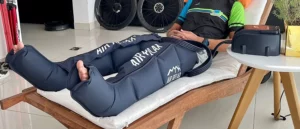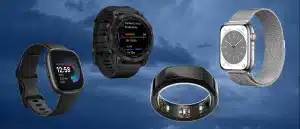Can Massagers for Sciatica Alleviate Pain?
- By Meghan De Maria
- March 29, 2024
Our product recommendations are selected by editors, tested first-hand, or expert-approved. We may earn a commission through links on our site.
So, you have a tingling pain in your leg that won’t go away. What gives? It could be sciatica, a common type of nerve pain that plagues 40 percent of U.S. adults at some point in their lifetime (1). Sciatica affects the muscles along your two sciatic nerves, which are actually a bundle of nerves that run from the lower back down each leg (1). The gold standard for treating sciatica is increasing mobility at the hands of a doctor or a physical therapist (and in some cases, adding over-the-counter meds or prescriptions to the mix), but using at-home massagers for sciatica is also becoming popular.
“A massage gun can be used to reduce muscle tension in the low back or legs,” says pain management specialist Gendai Echezona, M.D.
About the Experts
Caitlin Greenstein, D.P.T., O.C.S., is the lead physical therapist at Beyond Physical Therapy in Raleigh, NC. She’s also an orthopedic specialist.
Gendai Echezona, M.D., is a triple board-certified anesthesiologist, pain management specialist, and the owner of Premier Pain Care & Wellness in Norwalk, CT.
Jasmine Marcus, D.P.T., C.S.C.S., is a physical therapist and a certified strength and conditioning specialist in Ithaca, NY.
Mark Gugliotti, D.P.T., is an associate professor of physical therapy at the New York Institute of Technology.
What Is Sciatica?
“The term ‘sciatica’ can be used loosely to describe a wide range of diagnoses,” says physical therapist Caitlin Greenstein, D.P.T., O.C.S.
Physical therapist Jasmine Marcus, D.P.T., C.S.C.S. concurs, and adds that sciatic nerve pain isn’t always a diagnosis on its own. Rather, it can also just be “a symptom, similar to how having a cough is a symptom of having a cold or the flu or another ailment,” she says.
There are multiple causes of sciatic nerve pain. The most common ones include herniated disks, bulging disks, arthritis, stenosis (narrowing of spinal space), and trauma to the nerve, Greenstein says.
However, this pain “can also be a result of myofascial trigger points that can mimic sciatica symptoms,” she adds. Myofascial trigger points are sensitive knots within the muscles that form as a result of being overworked, and can cause pain (2).
Sciatica can include tingling pain or numbness and it frequently affects only one sciatic nerve (and consequently, only one leg).
Smoking (3) and sitting down too much or for too long (4) may increase the risk of sciatic pain. With smoking, the risk of sciatic pain is believed to increase because nicotine affects circulation. And with being sedentary, sitting down for too long can put undue pressure on your lower back—and negatively impacts circulation.
“Sciatica nerve pain is typically caused by compression on the sciatica nerve or an injury to spinal nerves in the low back that eventually become a part of the sciatic nerve,” Echezona explains. (And seeing a physical therapist can help inform you what movements may make you more prone to experiencing pain.)
While sciatica is often used as an umbrella term, there are a few common symptoms to look out for.
Symptoms of sciatica
Lower back pain. Greenstein says sciatica can include pain in the lower back, glutes, thighs, calves, and feet. She adds that “the pain can range from shooting, burning, or a dull ache.”
Burning or tingling down the leg. “Oftentimes people will experience tingling, numbness, weakness, and changes to their reflexes,” Greenstein says.
Weakness in the muscles of the affected leg. “Movement impairments vary, but in [some] cases, people feel worse sitting or bending and better standing or walking,” Greenstein says. “Symptoms are often worse in the morning and can negatively impact sleep.”
Massage Therapy and Sciatic Nerve Pain
To treat sciatic pain, Greenstein recommends “physical therapy, which can include dry needling, manual therapy, [and] movement-based interventions.” Manual therapy comes at the hands of a physical therapist, but she adds that “some cases respond well to foam rolling and self-massage,” which can be done at home.
“Physical therapy treatments include stretching, massage, neural mobilization, and exercises, including those with foam rolls,” says physical therapy associate professor Mark Gugliotti, D.P.T. “Patients may also choose to pursue chiropractic treatments, including manipulation, or see their physician, who can prescribe medication for pain and nerve irritability.”
Massage therapy has long been used to treat pain more generally (5). And deep-tissue massage (6)—which might also be achieved with massage guns and foam rollers—can help alleviate muscle soreness and muscular pain symptoms.
“It’s possible that the foam roller can be used to stretch and relieve tension in the low back,” Echezona says. However, she stresses this is only one part of pain treatment, and that seeing a medical professional, such as a physical therapist, is essential.
How to Use a Massage Gun for Sciatica
Massage guns use vibration therapy to treat muscular pain and improve circulation (7). They’re a powerful at-home tool for muscle recovery (8)—as long as you don’t use too much force.
“People should stay over large muscles, begin with a low intensity, and use gentle circular or sweeping motions,” Echezona says. When used correctly to massage sore muscles in your legs and back, massagers can reduce pain in the leg and low back (9).
It’s easy to overdo it with a massage gun or to think a higher intensity will lead to more pain relief. But if you misuse a massage gun, your recovery efforts can backfire. “Sometimes people think they’re not getting better unless their treatment hurts, but with sciatica, I would caution against doing anything that makes the pain or other symptoms worse,” Marcus says.
Be sure to treat the sciatic nerve itself with care. “I do not recommend the use of a massage gun directly over the sciatic nerve,” Echezona says. “Improper or aggressive treatments may cause more pain, swelling, and injury.” Gugliotti concurs, adding that “if used directly over the nerve, massage guns can increase symptoms.”
If you’re unsure of where your sciatic nerve is in your low back and leg, speak with a physical therapist about how to target the muscles surrounding it.
Echezona also advises not using massage guns “over bony areas or directly over the spine.” Massaging your muscles to alleviate pain is great (and safe!), but you don’t want to apply excess pressure to your bones.
What’s the best massage gun for sciatica?
The Theragun gets all the glory but it’s not the only at-home massager on the market. “There are many other affordable options that come with different attachments to treat multiple areas, like the Olsky deep-tissue massage gun,” Echezona says.
If your physical therapist doesn’t recommend any specific massagers for sciatica, our experts love these picks:
The Bottom Line
Massage guns and foam rollers can be one component of treating sciatic nerve pain. Before starting an at-home plan, consult a physical therapist or other medical professional and ask for a treatment plan to manage your pain.
References
1. Cleveland Clinic. Sciatica.
2. Cleveland Clinic. Myofascial Pain Syndrome.
3. Rahman Shiri, et al (2016). The Effect of Smoking on the Risk of Sciatica: A Meta-analysis.
4. Ulla Euro, et al (2019). Work-related risk factors for sciatica leading to hospitalization.
5. Cindy Crawford, BA, et al (2016). The Impact of Massage Therapy on Function in Pain Populations—A Systematic Review and Meta-Analysis of Randomized Controlled Trials: Part I, Patients Experiencing Pain in the General Population.
6. Marian Majchrzycki, et al (2014). Deep Tissue Massage and Nonsteroidal Anti-Inflammatory Drugs for Low Back Pain: A Prospective Randomized Trial.
7. Redha Taiar, et al (2023). Effect of Localized Vibration Massage on Popliteal Blood Flow.
8. Ricardo Maia Ferreira, et al (2023). The Effects of Massage Guns on Performance and Recovery: A Systematic Review.
9. Lorna Sams, et al (2023). The Effect Of Percussive Therapy On Musculoskeletal Performance And Experiences Of Pain: A Systematic Literature Review.












